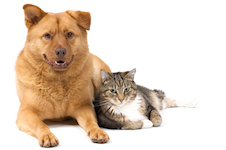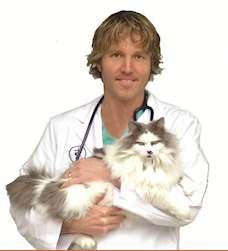 Hello and Good Morning to you and your furry friends, Friend.
Hello and Good Morning to you and your furry friends, Friend.
Before you embark on At home care for your dog or cat, there is somewhere you need to start.
Determining what is WRONG.
And this ALL begins with the At Home Pet Health Exam.
You can see EXACTLY how to do this in my video here:
http://www.theonlinevet.com
-----------------------------------
Do you know what normals are?
-----------------------------------
In being able to examine, diagnose and treat your pet at home, you've got to know what the "normal" values are for your pet.
Every pet has its own baseline Temperature, Pulse, Respiration, Gum Color, Capillary Refill, Hydration and Weight.
These are the specific details that you can follow to record your pet's baseline values.
Temperature -
Your pet probably has a range of what is normal, its temperature is not going to be the same everyday, I would take several readings to give yourself an idea of what is normal.
Lift your pets tail, this will help keep your pet from sitting down, it is also easier if you have someone holding the pretty end for you, using a rectal thermometer, lubricate the end with KY Jelly or petroleum jelly and insert the thermometer into the rectum of your pet about halfway. After 3 minutes you can remove the thermometer and write down the readings.
Normal ranges from 99 degrees F to 102 degrees F. ( 38-39.5 degress Celcius) Anything below 95 degrees F is an emergency, call your veterinarian and begin to warm your pet immediately. Anything above 106 degrees F is an emergency you need to call your veterinarian and begin to cool your pet immediately. If your pet's temperature is moderately high or low you still should call your veterinarian and alert them that something maybe wrong, it may not be an emergency now but it may become one if care is not given.
Heart Rate -
To measure your pets heart rate place your hand on the left side of your pets chest behind the elbow, you should be able to feel the beats of the heart. Count the number of beats for 15 seconds and multiply by 4, this will give you the number of beats per minute. Try to take several readings to give you an average heart rate, and it's good practice.
Also, try to find your pets pulse using the femoral artery, it is located in the groin area where the hind leg meets the body, press firmly with two fingers, you should easily feel the beats. In an emergency you may need to find a pulse on your pet, the best place is the femoral artery.
Normal heart rate for a dog can be 70 - 180 beats per minute, smaller dogs have a faster heart rate then larger breeds, puppies can be 220 beats per minute. Normal heart rate for a cat can be 120 - 240 beats per minute, kittens can be 200 - 300 beats per minute.
Respiratory Rate -
To measure your pets respiratory rate count the number of breaths for 15 seconds and multiply by 4, this gives you the number of breaths per minute. Dogs usually breathe 10 - 30 times a minute, cats 10 - 40 times a minute. A panting dog will breathe much faster, up to 200 times a minute, open mouth breathing or panting in cats should be considered an emergency.
Gum Color (mucous membranes) -
Checking your pets gum color is one way to alert you when something is wrong. The gum tissue should be nice and pink, if your pets gums are pigmented try to find a spot that is non-pigmented or use the mucous membrane tissue in the groin area. If your pets mucous membranes are anything other then pink, something is wrong and you should call your veterinarian.
Pale pink or white mucous membranes could spell shock or anemia, blue generally means your pet is having trouble breathing and not getting oxygen, yellow mucous membranes generally means your pet is jaundice and having liver problems, and bright red mucous membranes could mean heat stroke for your pet or carbon monoxide poisoning.
Capillary Refill Time -
This test helps to judge your pets blood circulation. Use the non-pigmented area of your pets gum tissue, press your finger against the tissue and release, there should be a white spot where your finger was, time how quickly the white spot becomes pink again. Normal ranges from 1 - 2 seconds, 2 - 4 seconds generally means shock or dehydration, more then 4 seconds is an emergency.
Hydration -
To check your pets hydration grasp the skin at the back of the neck and pull up, the skin should snap back rather quickly, the longer it takes to retract the more dehydrated your pet is. If the skin remains standing up you should call your veterinarian immediately.
You can also check hydration by pressing a finger to your pets gums, if they are sticky or tacky then your pet is dehydrated and your veterinarian should be called. Senior cats will generally be a little dehydrated, you may want to check with your veterinarian for what is considered normal for your senior cat.
Weight -
If your pet is small you can weigh yourself and then weigh yourself holding your pet and subtract. Larger dogs I would take to the veterinary clinic and ask to use there scales, there is generally no charge to do this. Weight loss can alert you to a problem internally with your pet, for example kidney disease, diabetes, and hyperthyroidism all list weight loss as a symptom. If you have noticed Weight loss call your veterinarian immediately.
///////////////////////////////////////////////////////
I can't emphasize enough the importance of a weekly exam.
Get used to the exam, and record your pet's baseline vital parameters today.
Then when your pet is sick or injured, you will be able to easily perform these tasks and come up with a quick plan of action.
It isn't complicated- But you've got to commit to doing it.
To see the simple steps on Video, go here:
http://www.theonlinevet.com
Heal Your Pets At Home!
Best Wishes,
Dr Andrew Jones

PRIVACY POLICY: We will never rent, sell, loan, provide, barter, exchange or in any way make available your personal information to others. You can unsubscribe or change your email address at any time using the links at the bottom of this email.
FTC DISCLOSURE: You can assume that in some cases Dr Andrew Jones and his Internet Company, Four Paws Online Ltd, has an affiliate relationship or material connection with the providers of the goods or service mentioned in this message and may be compensated if you are to purchase from an affiliate link. You should always perform due diligence before purchasing goods or services from anyone - online or offline. Be a responsible pet owner, be kind to animals and if you are not a breeder, spay or neuter your pets.
Copyright 2010 Four Paws Online Ltd.
Tel: 1-800-396-1534
Fax: 1-888-398-1378
www.veterinarysecretsrevealed.com
support@veterinarysecretsrevealed.com
|